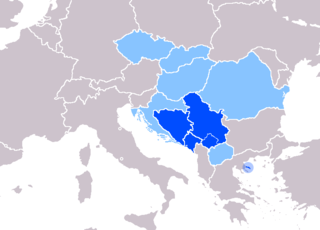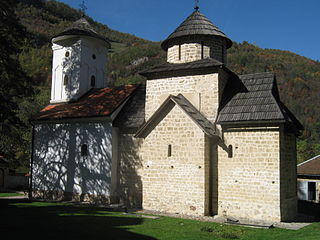
Mileševa is a Serbian Orthodox monastery located near Prijepolje, in southwest Serbia. It was founded by King Stefan Vladislav I, in the years between 1234 and 1236. The church has frescoes by the most skillful artists of that time, including one of the most famous in Serbian culture, the "White Angel", which depicts an angel on Christ's grave.
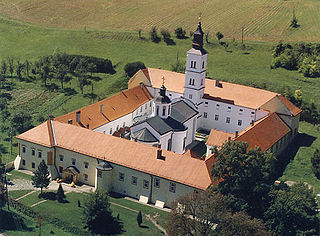
The Krušedol Monastery is a Serbian Orthodox monastery on the Fruška Gora mountain in the Syrmia region, northern Serbia, in the province of Vojvodina. The monastery is the legacy of the last Serbian despot family of Syrmia - Branković. Dedicated to the Annunciation to the Blessed Virgin Mary, it has been described as the "spiritual beacon" of Fruška Gora and "Second Studenica.

Đurđevi stupovi is a Serbian Orthodox monastery located in the vicinity of today's city of Novi Pazar, in the Raška region of Serbia.

The Beočin monastery is a Serbian Orthodox monastery, located just outside Beočin, on Fruška Gora mountain in the northern Serbian province of Vojvodina.

Krka Monastery is a Serbian Orthodox monastery dedicated to the Archangel Michael, located near the river Krka, 3 km east of Kistanje, in central Dalmatia, Croatia. It is the best known monastery of the Serbian Orthodox Church in Croatia and it is officially protected as part of the Krka National Park. It dates back to the 14th century.

Žitomislić is а Serbian Orthodox monastery dedicated to the Annunciation and located near Mostar, Bosnia and Herzegovina.

The Eparchy of Budimlja and Nikšić or Budimlja–Nikšić is an eparchy of the Serbian Orthodox Church, covering parts of western, central and eastern Montenegro. The ecclesiastical seat of the eparchy is the Monastery of the tracts of St. George in Berane.

The Tavna Monastery is a Serbian Orthodox monastery located south of the city of Bijeljina in north-eastern Republika Srpska, Bosnia and Herzegovina. The date of its foundation is unknown.
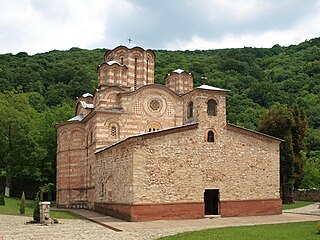
Ravanica is a Serbian Orthodox monastery on Kučaj mountains near Ćuprija in Central Serbia. It was built in 1375–1377 as an endowment of prince Lazar of Serbia, who is buried there. The Ravanica church is called the birthplace of the new artistic movement "Morava school" because of architectural and artistic features. It is original blend of the Mount Athos and the cross-in-square five-domed model that became standard in the time of King Milutin.
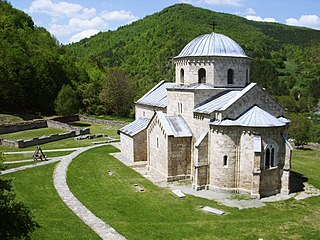
Gradac Monastery an endowment of queen Helen was built from 1277 to 1282 during the reign of her son king Stefan Dragutin. It lies on the elevated plateau above the river Gradačka, at the edge of the forested slopes Golija. Gradac Monastery was declared Monument of Culture of Exceptional Importance in 1979, and it is protected by Serbia.

The Church of St. Achillius, or the Arilje Monastery is a Serbian Orthodox church in Arilje, western Serbia. It is dedicated to Saint Achillius of Larissa, a fighter against Arianism and participant of the First Council of Nicaea in 325. The church was built in 1296 by Serbian King Stefan Dragutin of the Nemanjić dynasty and is located in the center of town, on the elevated plateau above the large river valley and the river Moravica and Big Rzav, and represents the most dominant object in the Arilje region.
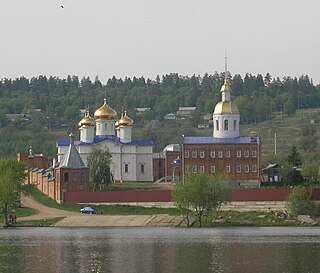
The Annunciation Monastery is a church complex in the village of Fedorovka in the urban district of Tolyatti in Samara Oblast in Russia.

The Tronoša Monastery is a Serbian Orthodox monastery between the villages of Tršić and Korenita, in the administrative town of Loznica, in western Serbia. It is ecclesiastically part of the Eparchy of Šabac. According to tradition, the monastery was built by King Stefan Dragutin.

The Dobrilovina Monastery is a Serbian Orthodox monastery in Donja Dobrilovina, Mojkovac, northern Montenegro. It is located on the left Tara river banks, in a region known as Potarje, at the beginning of the Tara River Canyon, the deepest river canyon in Europe. The village of Dobrihnina was mentioned in a Nemanjić charter in 1253, though the oldest preserved mention of the monastery dates back to 1592, when the Ottoman authorities allowed the locals to rebuild their monastery in Dobrilovina. In 1609, the current standing church dedicated to St. George was finished; the frescoes were finished by 1613. This church has been pillaged, abandoned, destroyed and renovated several times since its founding.

The Papraća Monastery is a Serbian Orthodox monastery dedicated to the Annunciation and located in the village of Papraća at the source of the same-named river, near Šekovići in eastern Republika Srpska, Bosnia and Herzegovina. The date of its foundation is unknown, but contemporary Ottoman documents give evidence that the monastery existed in the first half of the 16th century.

Janja Monastery is a Serbian Orthodox monastery located in Nova Varoš in southwestern Serbia. The monastery belongs to the Eparchy of Mileševa and is dedicated to the Righteous parents of the Holy Mother of God, Joachim and Anne. It is assumed it was built in the 15th century, and it was destroyed at the end of 17th century. in 1993, archaeological excavations of the site began, while in 2008 the restoration of the monastery began, finally being finished on July 22, 2012.

Pridvorica Monastery is a monastery of the Serbian Orthodox Church, built in the 12th century, at the same time as the nearby Studenica. It has the status of cultural monument of great importance. It is located in the village of Pridvorica, Ivanjica.
Majstorovina Monastery is a Serbian Orthodox monastery located in the village of Majstorovina in Bijelo Polje, Montenegro. It includes the Church of the Holy Trinity, dating back to the reign of Vukan Nemanjić. It was abandoned in the 17th century, its documents having been relocated to the Dobrilovina Monastery and the Nikoljac Monastery.

